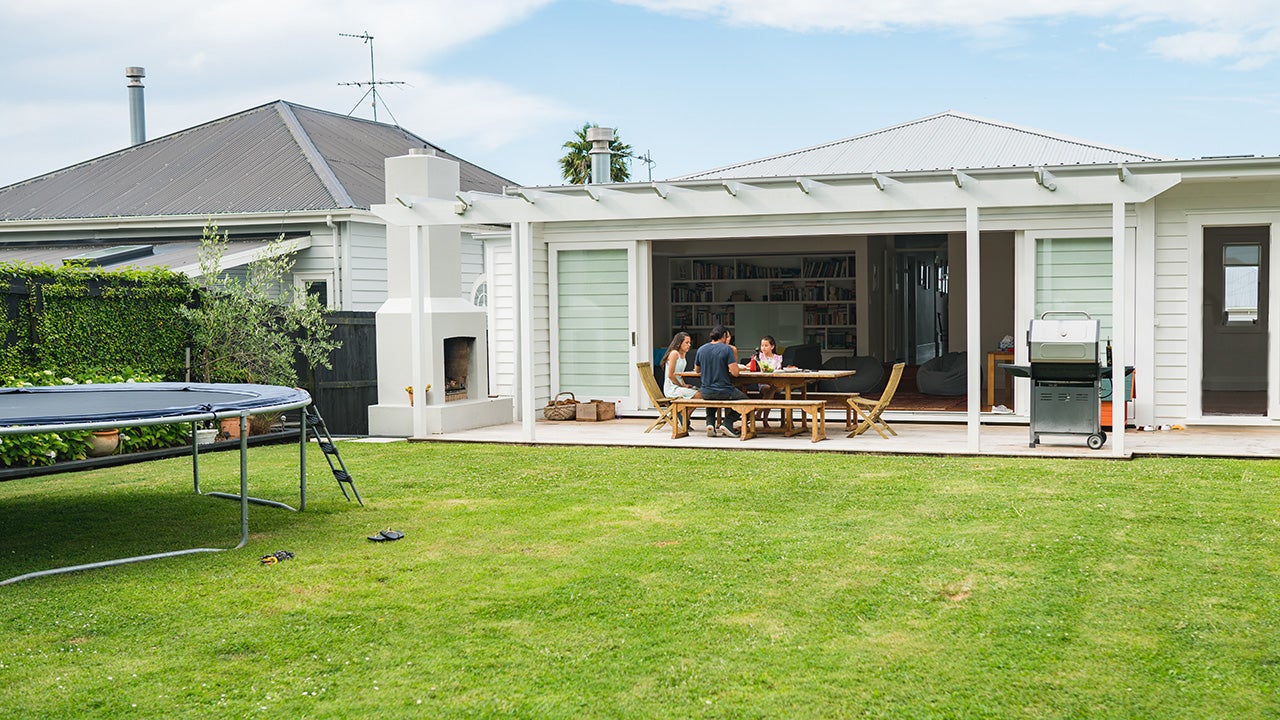Will your home insurance cost more in 2022? Bankrate finds out.

Home insurance rates are on the rise, and in most states, homeowners are bracing for more increases. S&P Global Market Intelligence reported that, since January 2022, insurance carriers have filed 177 requests for home insurance rate increases in 43 states, with Arizona topping the list at 34 rate increase filings.
Natural disasters are often cited as a major cause of rising home insurance rates, but as economic volatility continues into 2022, its influence can’t be ignored either. Bankrate explores the underlying causes behind changing home insurance rates and shares some strategies to help offset rate hikes where possible.
Are home insurance rates higher in 2022?
Before adjusting home insurance rates or changing underwriting guidelines, insurance companies must first request approval from a state’s Department of Insurance through a rate filing. To forecast how home insurance premiums might be affected by approved rate increases in 2022, Bankrate analyzed approved home insurance rate filing data from S&P Global Market Intelligence alongside our 2022 study of average home insurance premiums.
Based on S&P data from January 1, 2022 to May 18, 2022, home insurance companies have been approved for rate increases in almost every state, with an average rate increase of 4.48%. This means that with the current average cost of homeowners insurance at $1,383 per year for $250,000 in dwelling coverage, homeowners could soon be paying closer to $1,445 per year on average, or an additional $62, for the same coverage. However, digging further into the data reveals that not all rate changes are major rate increases, and some locations might see a minimal increase, or, in some cases, even see a decrease.
States with the highest home insurance rate percentage increases
California is currently anticipating the highest homeowners insurance rate increase at 15.3%. However, the impact across the state may be relatively low, as less than 8,800 policies are expected to be affected. In contrast, Washington home insurance policies are expecting a 12% increase to affect around 105,454 policyholders, meaning that Washington homeowners could pay an extra $108 a year, on average, for the same coverage. Arizona, Georgia and New Mexico are also preparing for rate increases, with an average rate increase of 10% affecting tens of thousands of policyholders.
| State | Percentage rate change | Number of policyholders affected |
|---|---|---|
| California | +15.3% | 8,769 |
| Washington | +12% | 105,454 |
| Arizona | +11.1% | Unavailable |
| Georgia | +9.9% | 60,464 |
| New Mexico | +9.1% | 77,514 |
States with the lowest home insurance rate percentage increases
As of May 2022, Maine and Delaware experienced an overall homeowners insurance rate percentage decrease, meaning that these states, where homeowners insurance is already much cheaper than the national average insurance cost, may get even cheaper. Although not included in the table below, Wisconsin, Ohio and Vermont have no rate changes from the prior year. Michigan, Kansas and New York are expected to have a marginal increase in home insurance rates, with an average increase of less than 0.5%.
| State | Percentage rate change | Number of policyholders affected |
|---|---|---|
| Maine | -1.5% | 2,106 |
| Delaware | -1.35% | 18,247 |
| Michigan | +0.04% | 137,046 |
| Kansas | +0.2% | 23,062 |
| New York | +1% | 252,694 |
Why are home insurance rates increasing?
When calculating home insurance rates, an insurance company’s priority is to manage risk. This means that the insurance company aims to balance the amount of claims paid out and its operating costs with incoming home insurance premiums. Home insurance rating factors, such as the location and age of a home, as well as the homeowner’s previous claims history, give an idea how likely a claim is to be filed. The riskier a home is — that is, the more likely a large claim will be filed — the more expensive the home insurance policy.
However, in recent years, home insurance claims have compounded across the nation. After absorbing the cost of claims for consecutive years and facing some of the factors discussed below, home insurance companies are now under pressure to re-evaluate their risk models, eligibility requirements and home insurance rates to stay afloat. Below are the largest insurance companies by market share and the expected rate increases in 2022:
| Company | Percent rate change | Number of policyholders affected |
|---|---|---|
| Farmers | +19.613% | 208,378 |
| Nationwide | +14.877% | 2,764 |
| Liberty Mutual | +13.76% | 94,592 |
| Chubb | +9.127% | 4,113 |
| Travelers | +7.338% | 116,196 |
| Progressive | +6.096% | 122,711 |
| Allstate | +3.076% | 2,577,660 |
| USAA | +2.666% | 99,002 |
| American Family | +0.679% | 35,861 |
Increase in catastrophic losses
Fueled by climate change and rapidly changing weather patterns, the occurrence of natural disasters has increased in the past few years. Every season, different parts of the country are impacted by intensified storms like winter storms and hurricanes, or catastrophic dangers like wildfire and flooding.
The increase and heightened severity of natural disasters has resulted in staggering reconstruction costs. The Insurance Information Institute (Triple-I) recorded 97 events that qualified as catastrophic losses in 2021, resulting in $92 billion of insured losses. This was up from 94 catastrophic events in 2020, resulting in $74 billion in insured losses. Although home insurance rates factor in estimated claims, losses of this magnitude forced many home insurance companies to take drastic action.
| 2019 | 2020 | 2021 | ||||
|---|---|---|---|---|---|---|
| Peril | Number of events | Insured losses* | Number of events | Insured losses* | Number of events | Insured losses* |
| Earthquake and geophysical | 2 | $50 | 4 | $58 | – | – |
| Floods, including flash floods | 9 | $200 | 4 | $2,200 | 12 | $2,850 |
| Severe thunder and convective storms | 49 | $20,300 | 51 | $35,000 | 64 | $26,740 |
| Tropical cyclone | 5 | $1,900 | 12 | $21,600 | 3 | $38,210 |
| Winter storms and cold waves | 16 | $2,100 | 4 | $930 | 4 | $15,520 |
| Wildfire, heat waves, and drought | 9 | $830 | 19 | $13,900 | 14 | $8,690 |
| Total | 90 | $25,500 | 94 | $74,000 | 97 | $92,000 |
*Losses in millions
Cost and availability of materials
Part of determining a home’s dwelling coverage and risk profile is calculating what it might cost to rebuild after a loss. This includes the cost of construction necessities, like labor costs and raw materials, so insurance companies factor this into the home insurance premium cost.
However, it’s now even more tricky to anticipate construction costs due to inflation and scarcity from supply chain issues. Figures from the Producer Price Index, which tracks the selling price of goods made by domestic producers, show a 4.9% increase in April 2022 for raw building materials compared to March 2022. The National Association of Homebuilders (NAHB) also reported that the cost of raw materials, which includes lumber, steel products, concrete and gypsum products, was up 19.2% compared to last year, and up 35.6% since the beginning of the pandemic in spring 2020.
Even as the price of raw materials continues to escalate, sourcing materials can also be a challenge. According to a May 2021 survey conducted by the NAHB and Wells Fargo, nearly all respondents had trouble finding plywood, copper wiring, windows and doors, appliances and more. Not being able to have the goods and materials ready at each stage of the construction process can delay timelines and exceed budgets, forcing home insurance companies to pay out more than expected during a claim.
Shortage and cost of labor
The effects of the Great Resignation touched all industries, including construction. According to a report released by the Associated General Contractors of America (AGC), 1.1 million employees left the construction industry from February to April 2020. The employment rate rebounded slightly in May 2020, especially in residential construction for homebuilding and remodeling, although growth has been stagnant. AGC suggested that many workers may have opted to move into other industries or leave the workforce.
Data from the Bureau of Labor Statistics shows that 2022 continues to be a challenging time for employers in the construction industry. The hiring rate for construction work slightly declined from 5.4% in February 2022 to 5.2% in March 2022, while separations, or employees leaving a company, continued to increase. Total separation, including both voluntary and involuntary resignations, reached its highest point in 2022 at 5.1% in March.
To retain current employees and attract new ones, raising pay is one strategy many construction companies are turning to. The AGC observed that, from February 2021 to January 2022, the hourly rate for construction employees rose 5.8%, although construction companies may still need to increase wages further in order to stay competitive. The struggle to retain employees and the higher cost of labor further contributes to overall more expensive construction costs that insurance companies need to consider when setting home insurance rates.
Course correction by home insurance carriers
Because of heavy losses sustained in recent years, many home insurance companies have reevaluated their business decisions. Raising home insurance premiums is only one course of action — others include being more selective about which areas insurers should to continue to renew or accept new business in, ceasing to do business in a state altogether or even total liquidation.
The current home insurance crisis in Florida is just one example of how dire things can become. Major losses from insurance fraud and natural disasters have made it hard for insurance companies to continue operating in the state. When insurers tighten restrictions or stop doing business in certain areas, it puts pressure on the remaining carriers to take on even more risk or implement stricter underwriting rules. This results in homeowners facing difficulty not just in finding affordable home insurance, but finding a home insurance carrier willing to accept them at all.
Are all home insurance policies affected?
Although the cost of home insurance may be increasing, this doesn’t mean that all home insurance policies will be more expensive. Your home insurance premium is based on individual rating factors such as where you live, the age and square footage of your home, and the claims rate of your area.
Additionally, the selected coverage and limits of your policy play an important role in your home insurance premium. Personalizing your policy with add-on endorsements can provide more protection with an additional fee, but taking advantage of discounts could be highly beneficial to making the final premium more affordable.
Also keep in mind that you will know if your new policy premium has increased before your renewal date. Your insurance company will send renewal policy declarations, including the new home insurance premium, in advance, so you have time to assess whether your premium has increased, what changes you can make and if you need to shop around.
Is it possible to avoid increased home insurance costs?
While there are steps you can take to manage your home insurance premium, it may not be possible to avoid a rate increase entirely. Furthermore, as a homeowner, you also have two main concerns when it comes to managing home insurance costs: your policy premium and whether your dwelling coverage limits are high enough to rebuild your home, especially as inflation and construction costs continue to be volatile.
Understanding your home insurance dwelling coverage
The factors causing home insurance premiums to rise may also impact how you calculate your dwelling coverage. Many homeowners are surprised to find that their home’s market value doesn’t have an impact on their home insurance rates — instead, it’s the cost of rebuilding the home that matters. Depending on the type of home insurance policy you have and if your policy uses replacement cost for dwelling coverage, you may also need to consider how and if depreciation may be a factor in the cost of rebuilding your home.
Over time, construction and labor costs naturally fluctuate and may be higher now than when you first purchased your home insurance policy. As a result, your dwelling coverage limits may no longer be high enough to fully rebuild your home. Some home insurance carriers account for this by incrementally increasing your dwelling coverage limits at renewal, while others offer an inflation guard endorsement for a separate fee, but it’s important to check your policy.
Another approach is to include extended replacement cost or guaranteed replacement cost as an optional add-on. Extended replacement cost increases your dwelling coverage limit by an additional percentage, typically either 25% or 50%, while guaranteed replacement cost will cover the full cost of rebuilding a home, even if it exceeds policy limits, Keep in mind that in order to have these replacement cost options apply, your dwelling coverage should be sufficient to insure your home to begin with. Additionally, these endorsements will raise your home insurance premium, sometimes significantly.
Reviewing your policy and comparison shopping
Even though rising home insurance rates might seem unavoidable, there are steps you can take that could result in savings:
- Review your current policy. Before making any changes to your home insurance policy, it is a good idea to review it to ensure your home is sufficiently insured. Also review any add-on endorsements to see if they’re necessary to protect your home. If you have any concerns, an insurance agent can help you review your policy, answer any questions and make recommendations.
- Ask about discounts. Taking advantage of all available discounts is one of the quickest ways to lower your home insurance premium. You may be able to earn home insurance discounts based on features of your home and installed safety and security features, but also from organization memberships, claims history, billing preferences and more.
- Include your other policies. A multiple-policy discount is often one of the largest discounts available. Along with the convenience of organizing all your insurance in one place, bundling your home and auto insurance with the same carrier could result in significant savings. Other policies that might qualify for a multiple policy discount include umbrella, boat or motorcycle insurance.
- Shop around for comparison quotes. Because every home insurance company calculates rates differently, shopping around for home insurance quotes could be a useful exercise. It may give you a better picture of the range you can expect to pay for home insurance and what a good deal might look like for you. When researching home insurance companies, note each company’s financial strength ratings from agencies like AM Best and Standard & Poor’s to get an idea of an insurance company’s ability to meet ongoing and future financial obligations.
Will home insurance prices go back down?
Home insurance rates are rarely static from year to year, even in periods of economic and market stability. In the short-term future, however, as inflation, labor shortages and supply chain issues continue, homeowners may see an increase in their home insurance policies until these issues resolve. As natural disasters continue to grow in frequency and intensity, government agencies, homeowners and insurance companies are bracing for more expensive repair costs.
Although homeowners insurance rates are rising, your policy is still based on your personal rating factors. For this reason, it’s possible that your home insurance premium could actually decrease. This might be because your region had fewer claims compared to previous years, your home is still relatively new and constructed with weather-proof materials, or you now qualify for more discounts. Checking in periodically with an insurance agent or company representative can be the best way to stay up to date with changes to your policy.
If you find that your homeowners insurance cost has significantly increased at renewal, keep in mind that there are still actions you can take to try and reduce the premium. A home insurance policy can be a valuable defense for your financial assets, which is why insurance experts and financial advisers advise keeping one in force.
Learn more:
You may also like

The 2024 election could impact auto and home insurance for voters in these 10 states

How to estimate your home insurance cost

Factors that impact your cost of homeowners insurance

Home insurance isn’t just more expensive, it’s also harder to get in 2025


